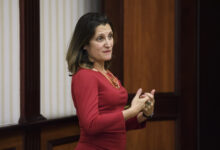It didn’t matter which operating plan was used to control the deluge of 2017 — likely the “most extraordinary to ever occur” in Lake Ontario and the St. Lawrence River — flooding was bound to occur, according to a recently released report.
“The total amount of water entering the system was overwhelming, setting records both at Lake Ontario and in the St. Lawrence River, causing a record rise in water levels,” says the report, produced by the International Lake Ontario-St. Lawrence River Board, which is appointed by the International Joint Commission.
The flooding, precipitated by a yo-yo winter, “unprecedented ice conditions” and a wet spring, caused “severe damage and distress,” it says, noting that from January to the end of May, Lake Ontario rose about 1.4 metres.
“We had a flooded Lake Ontario flowing into a flooded St. Lawrence River. That’s what it boils down to, and that went on for weeks,” said Rob Caldwell, secretary of the board.
The event broke multiple records and the board took exceptional measures.
The board controls outflows from Lake Ontario with the Moses-Saunders Dam, which stretches between Cornwall and Massena, N.Y., Caldwell said. Ancillary to it is the Long Sault Dam.
Water levels were so high that the board discharged more water from the dam than it otherwise would. In late May, it increased outflows above levels set out in the regulation plan, in order to lower water levels in the lake and provide relief. The discharge from the dam was eventually reduced in early August.
The board implemented a new regulation in January 2017 called Plan 2014.
Caldwell said “major deviations” cannot be undertaken until extreme levels are reached.
Frank Sciremammano, a former member of the board, said he agrees with the report, noting the flooding “would have occurred anyway.”
But he has a bone to pick with Plan 2014, because all damages were lumped on Lake Ontario, particularly the south shore, he said.
“It’s inconsistent with protection against extremes,” Sciremammano said. “It actually allows for extremes and that was demonstrated last year. They’ve basically taken away the protection on the lake. It’s a government breaking their promise.”
Caldwell, from the board, said flooding was managed to the best of its ability.
“We observed exceptional conditions, record flooding, record rainfall, and I don’t think we could’ve done much more to reduce the peak further than we already did. I think we did the best we could with the limitations we had on hand,” he said, noting that Plan 2014 did not “exacerbate” the flooding.
Pegged to the issue are infrastructural limitations, Caldwell said.
“We were limited in how much water we could release through the dam here, so that we prevented worsening the flooding that was occurring down from Montreal down through to almost Quebec City,” he said.
“The record-high flows released in 2017 increased the velocity of currents in the St. Lawrence River,” the report says, and, if it was to increase them further, it would have put ships at risk and potentially halted commercial vessels.
“It’s always about balance and compromise at the end of the day,” Caldwell said, noting that Lake Ontario, the St. Lawrence River and the Ottawa River all received record amounts of rainfall.
“The folks in Toronto were deeply concerned, Toronto Islands, especially, were heavily impacted. They feel violated by this flooding. It’s a very personal thing,” he said.
The report notes that, taken together, April and May of 2017 were “the wettest two month period ever recorded for Lake Ontario.”
Toronto, Ottawa, Montreal, Rochester and Buffalo all broke rainfall records last year, Caldwell said. Toronto had the least amount of the five; gauged at Pearson Airport, there was 10 inches of rain over 40 days, he said.
Extreme weather is projected to happen again, Caldwell said, highlighting the need to bridge partnerships with stakeholders and communities “so damages can be reduced” further.
“Flooding will occur again,” he said. “It’s not a matter of if, but when. We need to be partnered up. Those inflows are going to do whatever Mother Nature throws our way.
“We’re going to look at 2017 with an extreme condition lens, so it’ll give us good guidance for future considerations as to how we might be able to tweak that regulation plan and get better performance out of it,” Caldwell said.
Sapna Sharma, associate professor of biology at York, said extreme weather, caused in part by climate change, is likely the “new normal.”
“The projections are expecting more precipitation and especially in the form of heavy storms,” she said, noting that when it does rain, it will pour, “which is troubling because we don’t have the infrastructure.”
Beyond dams, there are other solutions that come from the natural world, Sharma said.
“We’re converting all our green space into concrete, which doesn’t absorb any water, then we have runoff,” she said. “More green space, for one, will definitely help, and restoring our wetlands.








Redes Sociais - Comentários